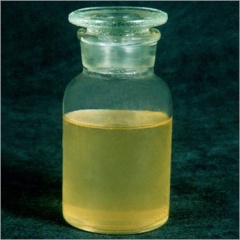Aniline
| Infobox on Aniline | |
|---|---|
| Example of Aniline |  |
| Facts | |
| Origin | - |
| Stowage factor (in m3/t) | Aniline oil; 1,5 m3/t in drums |
| Humidity / moisture | |
| Ventilation | |
| Risk factors | Toxic if absorbed through the skin. |
Aniline
Description
Aniline, phenylamine or aminobenzene is an organic compound with the formula C6H5NH2. Consisting of a phenyl group attached to an amino group, aniline is the prototypical aromatic amine. Being a precursor to many industrial chemicals, its main use is in the manufacture of precursors to polyurethane. Like most volatile amines, it possesses the somewhat unpleasant odor of rotten fish. It ignites readily, burning with a smoky flame characteristic of aromatic compounds. Aniline is colorless, but it slowly oxidizes and resinifies in air, giving a red-brown tint to aged samples.
Aniline is mainly produced in industry in two steps from benzene. First, benzene is nitrated using a concentrated mixture of nitric acid and sulfuric acid at 50 to 60°C, which gives nitrobenzene. In the second step, the nitrobenzene is hydrogenated, typically at 200-300 °C in presence of various metal catalysts.
Originally, the reduction was effected with a mixture of ferrous chloride and iron metal via the Bechamp reduction.
As an alternative, aniline is also prepared from phenol and ammonia, the phenol being derived from the cumene process.
In commerce, three brands of aniline are distinguished: aniline oil for blue, which is pure aniline; aniline oil for red, a mixture of equimolecular quantities of aniline and ortho- and para-toluidines; and aniline oil for safranine, which contains aniline and ortho-toluidine, and is obtained from the distillate (échappés) of the fuchsine fusion.
Application
The largest application of aniline is for the preparation of methylene diphenyl diisocyanate (MDI). The majority of aniline serves this market. Other uses include rubber processing chemicals (9%), herbicides (2%), and dyes and pigments (2%). As additives to rubber, aniline derivatives such as phenylenediamine and diphenylamine, are antioxidants. Illustrative of the drugs prepared from aniline is paracetamol (acetaminophen, Tylenol). The principal use of aniline in the dye industry is as a precursor to indigo, the blue of blue jeans.
Aniline is also used at a smaller scale in the production of the intrinsically conducting polymer polyaniline.
Shipment/storage
A by-product of coal-tar which emits fumes of a very dangerous character. Generally shipped either as oil in drums or crystals in casks. The oil fumes are very penetrating and taint goods stowed with or near this cargo; furthermore, the oil leaves damaging stains on whatever it contacts with. Ships have been put to very great expense in freeing holds of the taint of Aniline Oil, entire compartments having had to be scrubbed with soap and water. Stow in poop, or forecastle, away from foodstuffs and crew's quarters, and well removed from Bleaching Powder as the mixture of their gases is dangerous.
The product is soluble in alcohol, ether, benzene and water.
Aniline Oil
A colourless liquid, turning brown on exposure to air and light. Shipped in drums. Fumes are very penetrating. May taint other goods and leaves damaging stains on any contact. Toxic if swallowed, by inhalation or in contact with skin
Aniline Salt
White crystals, darkening in light and air. Decomposes to aniline in contact with alkalis. Shipped in casks. May give off toxic vapour. Any spillage stains. Should be stowed away from foodstuffs.
Aniline dyes
A large class of dyes made from aniline. Toxic and irritating to eyes and skin. Will leave damaging stain on any contact.
Risk factors
Toxic if absorbed through the skin.
See IMDG Code











